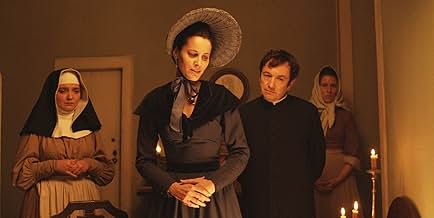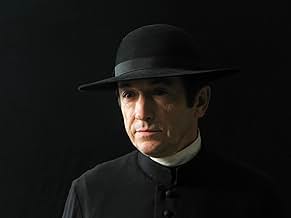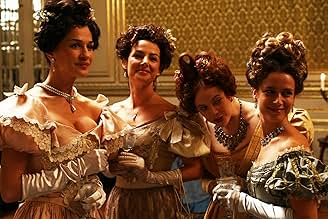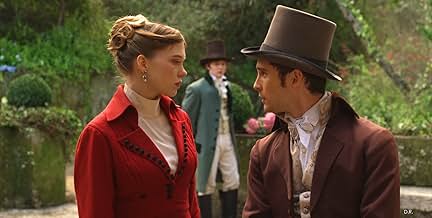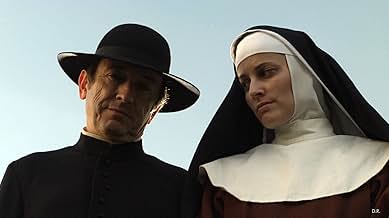IMDb-BEWERTUNG
7,4/10
3646
IHRE BEWERTUNG
Füge eine Handlung in deiner Sprache hinzuFollows a jealous countess, a wealthy businessman, and a young orphaned boy across Portugal, France, Italy and Brazil where they connect with a variety of mysterious individuals.Follows a jealous countess, a wealthy businessman, and a young orphaned boy across Portugal, France, Italy and Brazil where they connect with a variety of mysterious individuals.Follows a jealous countess, a wealthy businessman, and a young orphaned boy across Portugal, France, Italy and Brazil where they connect with a variety of mysterious individuals.
Folgen durchsuchen
Empfohlene Bewertungen
The Mysteries of Lisbon are not so much mysteries as they are a series of conversations which always lead to some sort of revelation. These revelations are melodramatic punch lines with interlocking characters continuously finding out who their parents are, where they came from, the results of lost loves, and everything in between. If the script was written in a linear fashion with no time jumps or flashbacks, there would be no mysteries; it would just be a meandering retelling of Romeo and Juliet (and all of their cousins).
The word meandering sounds harsh and an indictment of a script which does not know where it is going. However, I mean meandering as in there are multiple lead characters to follow and each of them has a very complicated past which takes its time to tell. The Mysteries of Lisbon is four and a half hours long; the director threw out accepted norms for audience patience in favor of showing the whole story. It is based on an 1854 novel by the Portuguese author Camilo Castelo Branco and it appears it was filmed in an unabridged fashion.
The main character is a village priest, Padre Denis (Adriano Luz), who at first is indirectly involved in a couple's forbidden love affair and then purposefully injects himself into their lives and then into everyone else's life who comes into contact with their troubles. Even though the priest is the interconnecting cog in the middle of all of these characters, he is not the narrator. That role is given to an orphan the priest looks after and becomes a driving force of his own later on.
The director, Raul Ruiz, obviously loves conversations, but only deep and emotionally scarring ones. Every conversation or recounting of a previous conversation has its own 30 minute segment it seems. The characters, usually just two, sit in a room and then the scene fades into flashback on what happened in the past which will now illuminate the present. I believe the time shifts were included to create the mystery. The author deliberately created the tension of not knowing and the 'a-ha' discovery moments because he could not have accomplished the same moments with a realistic, linear timeline.
The action is mostly set in Portugal and appears to be in the early 1800s but after Napoleon. The Emperor is frequently referenced but only in the past tense. Many of the characters are nobles so the costume designer had a true feast in outfitting so many people in remarkable period dress. The Portuguese scenery and elaborate set designs are also enjoyable; somebody really took their time to make the set look intensely real. The lighting is also employed to convey a sense of realness. There seems to be no artificial lighting whatsoever. Light only comes through windows during the day and the rooms are terrifically dark at night. The candles never flicker so there must be some source of artificiality, but it is not noticeable. Unfortunately, Raul Ruiz recently passed away on 19 August. He was Chilean born but left Chile in 1973 when Augusto Pinochet took power. The Mysteries of Lisbon is his final film and is of such epic proportions it appears he was thinking about this film for a long time before he finally took the plunge.
I recommend this film, but be careful. Watch it only if you appreciate long, intense scenes of dialogue or appreciate the intricate details of period films. There is extremely little action and drawn out sequences with no words spoken at all; however, there is character with the endearing name 'Knife Eater'. If these aspects do not scare you, then sit back and enjoy because you are in for a real treat. You will not see a film like this from an American director; no studio would ever sign off on a movie this long, not if they expect it to make any money.
The word meandering sounds harsh and an indictment of a script which does not know where it is going. However, I mean meandering as in there are multiple lead characters to follow and each of them has a very complicated past which takes its time to tell. The Mysteries of Lisbon is four and a half hours long; the director threw out accepted norms for audience patience in favor of showing the whole story. It is based on an 1854 novel by the Portuguese author Camilo Castelo Branco and it appears it was filmed in an unabridged fashion.
The main character is a village priest, Padre Denis (Adriano Luz), who at first is indirectly involved in a couple's forbidden love affair and then purposefully injects himself into their lives and then into everyone else's life who comes into contact with their troubles. Even though the priest is the interconnecting cog in the middle of all of these characters, he is not the narrator. That role is given to an orphan the priest looks after and becomes a driving force of his own later on.
The director, Raul Ruiz, obviously loves conversations, but only deep and emotionally scarring ones. Every conversation or recounting of a previous conversation has its own 30 minute segment it seems. The characters, usually just two, sit in a room and then the scene fades into flashback on what happened in the past which will now illuminate the present. I believe the time shifts were included to create the mystery. The author deliberately created the tension of not knowing and the 'a-ha' discovery moments because he could not have accomplished the same moments with a realistic, linear timeline.
The action is mostly set in Portugal and appears to be in the early 1800s but after Napoleon. The Emperor is frequently referenced but only in the past tense. Many of the characters are nobles so the costume designer had a true feast in outfitting so many people in remarkable period dress. The Portuguese scenery and elaborate set designs are also enjoyable; somebody really took their time to make the set look intensely real. The lighting is also employed to convey a sense of realness. There seems to be no artificial lighting whatsoever. Light only comes through windows during the day and the rooms are terrifically dark at night. The candles never flicker so there must be some source of artificiality, but it is not noticeable. Unfortunately, Raul Ruiz recently passed away on 19 August. He was Chilean born but left Chile in 1973 when Augusto Pinochet took power. The Mysteries of Lisbon is his final film and is of such epic proportions it appears he was thinking about this film for a long time before he finally took the plunge.
I recommend this film, but be careful. Watch it only if you appreciate long, intense scenes of dialogue or appreciate the intricate details of period films. There is extremely little action and drawn out sequences with no words spoken at all; however, there is character with the endearing name 'Knife Eater'. If these aspects do not scare you, then sit back and enjoy because you are in for a real treat. You will not see a film like this from an American director; no studio would ever sign off on a movie this long, not if they expect it to make any money.
10RMHolt77
MYSTERIES OF LISBON is a staggeringly immense epic, weaving together multiple narratives of operatic passion and desire into a broader memory-narrative patchwork. The late Raul Ruiz draws upon great predecessors to set the visual tone (there's plenty of Visconti's THE LEOPARD and Kubrick's BARRY LYNDON here), but then toys with the aesthetic by adding playfully surreal touches, so that the events seem perched on the edge of a dream. By design, it's all a bit messy, one narrative tumbling into the other, but Ruiz displays such complete mastery of the medium that MYSTERIES OF LISBON remains gripping, even over the course of its four-hour running time.
The word "masterpiece" is fairly overused, and as a result, devalued, but MYSTERIES OF LISBON is the real thing.
The word "masterpiece" is fairly overused, and as a result, devalued, but MYSTERIES OF LISBON is the real thing.
10Fotodude
It's almost a miracle to find a film like this one in theaters nowadays. An exceptional rarity, something that reminds you that cinema like this can still be achieved. Being a period piece, and with almost 5 hours of runtime (the 15-minute intermission included), it defies almost every convention of commercial cinema. And it doesn't drag one bit; every minute of the film is required, and while it absorbs you and doesn't let go, you feel grateful for it
For those magical hours of hypnotic escapism.
"Mysteries of Lisbon" is en epic, mesmerizing adaptation of the homonym novel by Camilo Castelo Branco. It tells a series of interconnected stories set mostly in 19th century Lisbon, although the main plot is pretty much unique. In any case, the way each story leads to the other and how it all comes together towards the end is brilliant. The two main characters are Pedro da Silva and Padre Dinis; a priest and an orphan destined to form a close bond. But all characters are carefully fleshed out; apart from those two, Ângela de Lima (Pedro's mother) or Alberto de Magalhães, among others, stand out. It is the film's purpose to explore the enigmatic nature of most of these people, leaving them and coming back to them with deeply measured fluency, bringing forward through the set occasional details of their personality, frequently using voice-overs to convey their inner thoughts while staying faithful to the literary source material.
This last idea is also present in how much the act of observation matters in this film. In a great number of scenes, a lesser character is either listening to what is happening or watching that given scene from a distance, thus often adopting the viewer's external point of view. This objective is made clear through the miniaturist theater that Pedro receives as a present from his mother, a toy that Ruiz goes back to on several occasions to mark the transition between a scene and the next. It is a beautiful little trick and, in some way, it provides part of the film's complexity. This complexity is reinforced by a few ambiguous notes, some surrealist touches and of course the multiple layers of the plot.
Another remarkable aspect is the use of clear-cut sequence shots for the majority of scenes, each of those shots more impressive than the other. The film has therefore very few close-ups, something that would also contribute to create a certain distance with the viewer. Only in a couple of situations (usually of lesser significance) does Ruiz go back to a more orthodox way of shooting. But those delightfully crafted sequence shots give the film an extraordinary, almost intoxicating energy, especially when they are accompanied by the film's haunting score. That way, every shot is a wonder in terms of composition, but also as far as the lighting is concerned. Just a few marvelous examples would be the scene at the opera hall or when Alberto de Magalhães confronts another man while Padre Dinis is traveling in the calash. Indeed, this must be one of the most striking films I've had the chance to see on the big screen.
On the whole, this is a moving, tragic and awe-inspiring masterpiece. A feast for the senses, and an immediate entry in my top 50. *****
"Mysteries of Lisbon" is en epic, mesmerizing adaptation of the homonym novel by Camilo Castelo Branco. It tells a series of interconnected stories set mostly in 19th century Lisbon, although the main plot is pretty much unique. In any case, the way each story leads to the other and how it all comes together towards the end is brilliant. The two main characters are Pedro da Silva and Padre Dinis; a priest and an orphan destined to form a close bond. But all characters are carefully fleshed out; apart from those two, Ângela de Lima (Pedro's mother) or Alberto de Magalhães, among others, stand out. It is the film's purpose to explore the enigmatic nature of most of these people, leaving them and coming back to them with deeply measured fluency, bringing forward through the set occasional details of their personality, frequently using voice-overs to convey their inner thoughts while staying faithful to the literary source material.
This last idea is also present in how much the act of observation matters in this film. In a great number of scenes, a lesser character is either listening to what is happening or watching that given scene from a distance, thus often adopting the viewer's external point of view. This objective is made clear through the miniaturist theater that Pedro receives as a present from his mother, a toy that Ruiz goes back to on several occasions to mark the transition between a scene and the next. It is a beautiful little trick and, in some way, it provides part of the film's complexity. This complexity is reinforced by a few ambiguous notes, some surrealist touches and of course the multiple layers of the plot.
Another remarkable aspect is the use of clear-cut sequence shots for the majority of scenes, each of those shots more impressive than the other. The film has therefore very few close-ups, something that would also contribute to create a certain distance with the viewer. Only in a couple of situations (usually of lesser significance) does Ruiz go back to a more orthodox way of shooting. But those delightfully crafted sequence shots give the film an extraordinary, almost intoxicating energy, especially when they are accompanied by the film's haunting score. That way, every shot is a wonder in terms of composition, but also as far as the lighting is concerned. Just a few marvelous examples would be the scene at the opera hall or when Alberto de Magalhães confronts another man while Padre Dinis is traveling in the calash. Indeed, this must be one of the most striking films I've had the chance to see on the big screen.
On the whole, this is a moving, tragic and awe-inspiring masterpiece. A feast for the senses, and an immediate entry in my top 50. *****
When Raoul Ruiz adapts existing material, he tends to reconfigure the narrative in a playful way, often obliterating all coherence in the process. In his writings on film, specifically Poetics of Cinema, he is quite critical of what he calls central conflict theory. The idea behind this theory is that narrative, especially film narrative, must be built around a single conflict and that every aspect of the plot must build on this conflict one way or another. Ruiz noticed this phenomenon and gave it a name, but it was so common that popular screen writing guides used it as an incontrovertible rule. Poetics of Cinema is devoted almost entirely to explaining and criticizing central conflict theory. Ruiz was never content merely to criticize this simplistic yet ubiquitous narrative structure in writing, however; commentary on it is often embedded in the films he makes. Unsurprisingly, his films intentionally eschew anything resembling this structure but they tend to go even further and offer playful deconstructions of the concept.
Although I can't claim much familiarity with the novel Ruiz is adapting in Mysteries of Lisbon (it apparently hasn't been translated to English yet) it undoubtedly lends itself especially well to his ludic, subversive style. Rather than follow the conflict of a single continuous narrative, Mysteries of Lisbon explores several interrelated narrative strands that complement one another unusually well as they're full of cases of important coincidental relationships and frustrated love affairs. Thus, Ruiz has less to subvert and more to emphasize.
Ruiz's visual style has always been highly unusual. He favors the frequent use of Dutch angles and he often creates startling juxtapositions with his unusual framing techniques and occasional superimpositions. While these unusual techniques are always welcome, they can become somewhat exhausting when they occur frequently. Since Mysteries of Lisbon is unusually long (the version I watched was around 260 minutes) it's perhaps unsurprising that Ruiz manages to space these out carefully enough to draw attention to all the right places and break up the monotony of the more conventional period piece style he favors in this film. Even at its least inspired, however, Mysteries of Lisbon offers far more visual stimulation than the stuffy fidelity of a film by Merchant and Ivory or Oscar fodder such as The King's Speech. Unlike most directors working with similar material, Ruiz captures vast landscapes and baroque interiors with the same effortless mastery. Even the frequent long takes are made more interesting by carefully employed tracking shots.
Mysteries of Lisbon represents the rare combination of a director at the top of his game working with material perfectly suited for his unique sensibilities. Cinema doesn't get much better than this.
Although I can't claim much familiarity with the novel Ruiz is adapting in Mysteries of Lisbon (it apparently hasn't been translated to English yet) it undoubtedly lends itself especially well to his ludic, subversive style. Rather than follow the conflict of a single continuous narrative, Mysteries of Lisbon explores several interrelated narrative strands that complement one another unusually well as they're full of cases of important coincidental relationships and frustrated love affairs. Thus, Ruiz has less to subvert and more to emphasize.
Ruiz's visual style has always been highly unusual. He favors the frequent use of Dutch angles and he often creates startling juxtapositions with his unusual framing techniques and occasional superimpositions. While these unusual techniques are always welcome, they can become somewhat exhausting when they occur frequently. Since Mysteries of Lisbon is unusually long (the version I watched was around 260 minutes) it's perhaps unsurprising that Ruiz manages to space these out carefully enough to draw attention to all the right places and break up the monotony of the more conventional period piece style he favors in this film. Even at its least inspired, however, Mysteries of Lisbon offers far more visual stimulation than the stuffy fidelity of a film by Merchant and Ivory or Oscar fodder such as The King's Speech. Unlike most directors working with similar material, Ruiz captures vast landscapes and baroque interiors with the same effortless mastery. Even the frequent long takes are made more interesting by carefully employed tracking shots.
Mysteries of Lisbon represents the rare combination of a director at the top of his game working with material perfectly suited for his unique sensibilities. Cinema doesn't get much better than this.
This series of short stories set in a world long gone is of course a costume drama, that may therefore deter some. They would be mistaken. It is slow, considered, colorful and in my view a good introduction to the world of our ancestors, who held opinions different from ours, did things in a different way, and got upset about the same issues, yet in a different clothing. Love that is thwarted, wise padres, noble families with poor youngest children and all of that in a heavily draped world - sometimes a bit much. And yet I may recommend that you sit down, do not hurry, leave your perhaps preconceived ideas at the entrance, and enjoy these so many hours of romantic stories.
Wusstest du schon
- PatzerThe movie is set during the late 1700's to early 1800's. During the ballroom scene, several shots make it obvious that the gowns worn by the women have zippers in the back but the zipper wasn't invented until 1851.
- Alternative VersionenAlso exists as a shorter (by about an hour), theatrically released, feature film version, Mistérios de Lisboa (2010).
- VerbindungenEdited from Mistérios de Lisboa (2010)
Top-Auswahl
Melde dich zum Bewerten an und greife auf die Watchlist für personalisierte Empfehlungen zu.
- How many seasons does Mysteries of Lisbon have?Powered by Alexa
Details
- Erscheinungsdatum
- Herkunftsländer
- Offizielle Standorte
- Sprachen
- Auch bekannt als
- Die Geheimnisse von Lissabon
- Drehorte
- Produktionsfirmen
- Weitere beteiligte Unternehmen bei IMDbPro anzeigen
Zu dieser Seite beitragen
Bearbeitung vorschlagen oder fehlenden Inhalt hinzufügen



